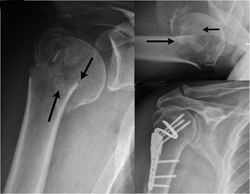Gap-filling plate could aid osteosynthesis of impacted humeral neck fractures
 Eduardo F. Carrera |
COPENHAGEN, Denmark — When surgically treating 2-, 3- and 4-part impacted humeral neck fractures, a Brazilian surgeon now recommends using a specially designed plate to fill the gap between multiple fracture fragments. The plate decompresses the fragments, moving the humeral head and shaft into more anatomical positions.
“In my opinion complex [impacted] fractures are the most difficult fractures to be treated if we don’t understand and accept that there is bone loss in an impacted bone area. After reduction, there is a gap that needs to be filled,” Eduardo F. Carrera, MD, of Sao Pãolo, said at the 12th EFORT 2011 Congress, here.
He noted these multi-part, displaced humeral neck fractures can result in concomitant bone loss that can affect not only vascularity, but also stability between fragments.
Bone loss analyzed
In Carrera’s study, he and colleagues compared a locked, angled gap-filling plate used for compressive fractures with a locking angle blade plate for non-compressive fractures in 48 shoulders treated at their center between January 2002 and August 2007. The study had a mean follow-up of 26 months.
|
Image: Carrera EF |
The plate studied, made by a Brazilian company, is not commercially available, however I.Ceram SARL, in Limoges, France, has begun manufacturing a similar plate that it expects to market eventually, according to Carrera.
For their study, investigators first classified the fractures into two groups — impacted or nonimpacted — and defined impacted humeral neck fractures as ones with permanent bone loss due to compression between the bone fragments. They then defined nonimpacted humeral neck fractures as those lacking any bone loss.
After performing the appropriate surgeries, the investigators found a mean Constant score of 76 in the series. The mean Constant score was 82 for the nonimpacted group and 68 for the impacted group. Furthermore, 14 of the cases involving impaction with bone loss developed avascular necrosis (AVN).
“The gap needs to be filled to help keep the fracture fragments stable,” he said.
Avoid postoperative instability
“The most important point is to understand that most of the complex proximal humeral fractures and/or impacted fractures present a gap in the humeral neck after the fracture reduction. This is due to the mechanism of compression between the fragments,” Carrera told Orthopaedics Today Europe. “This plate fills the gap between the humeral head and the shaft and gives support to attach the bone fragments. The other plates/techniques don’t fill the gap (bone loss after the compression between the fragments – humeral head against the shaft); then the screw fixation becomes more difficult during the surgery and unstable after the surgery. This gap-filling plate makes the surgery easier, faster and safer.”
Carrera said that at the 11th International Conference on Surgery of the Shoulder held in Edinburg in 2010 he and colleagues reported 85% good results with the technique. They are currently analyzing their findings with regard to complications and AVN, as well as comparing any mechanical differences between the new plate and the traditional locked plates they evaluated, he said. – by Susan M. Rapp
Reference:
- Carrera EF, Marchetto A, Reis F. A different way to understand and to treat the displaced humeral neck fractures. Paper #667. Presented at the 12th EFORT Congress 2011. June 1-4. Copenhagen, Denmark.
- Eduardo F. Carrera, MD, can be reached at Rua Borgese Lagoa 786, 04038-001 Sao Pãolo, SP Brazil; email: e.carrera@me.com.
- Disclosure: Carrera has no relevant financial disclosures.


